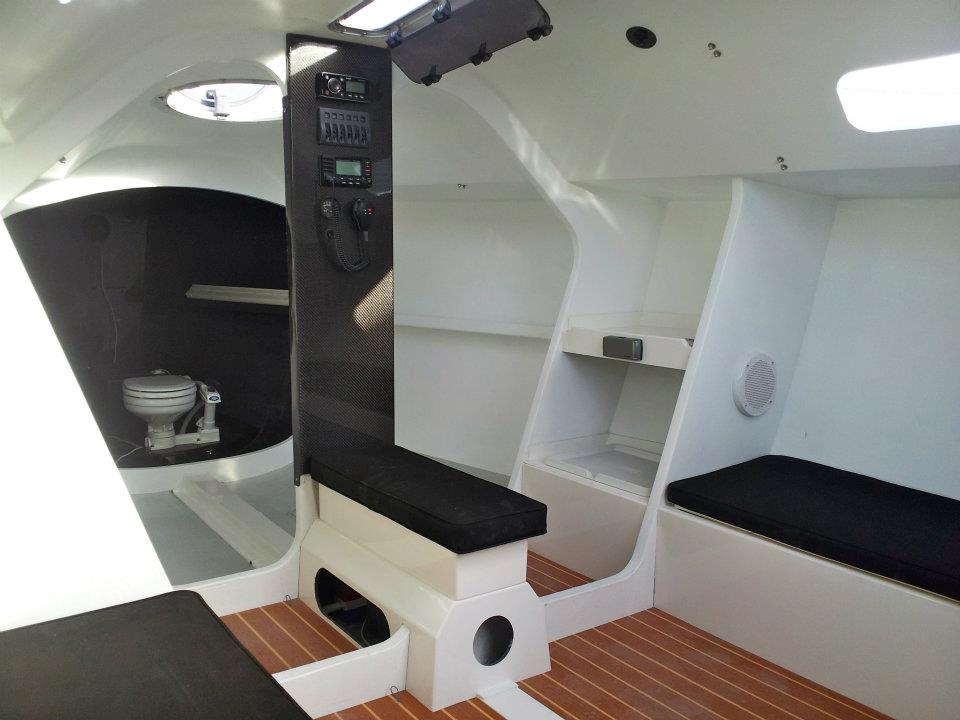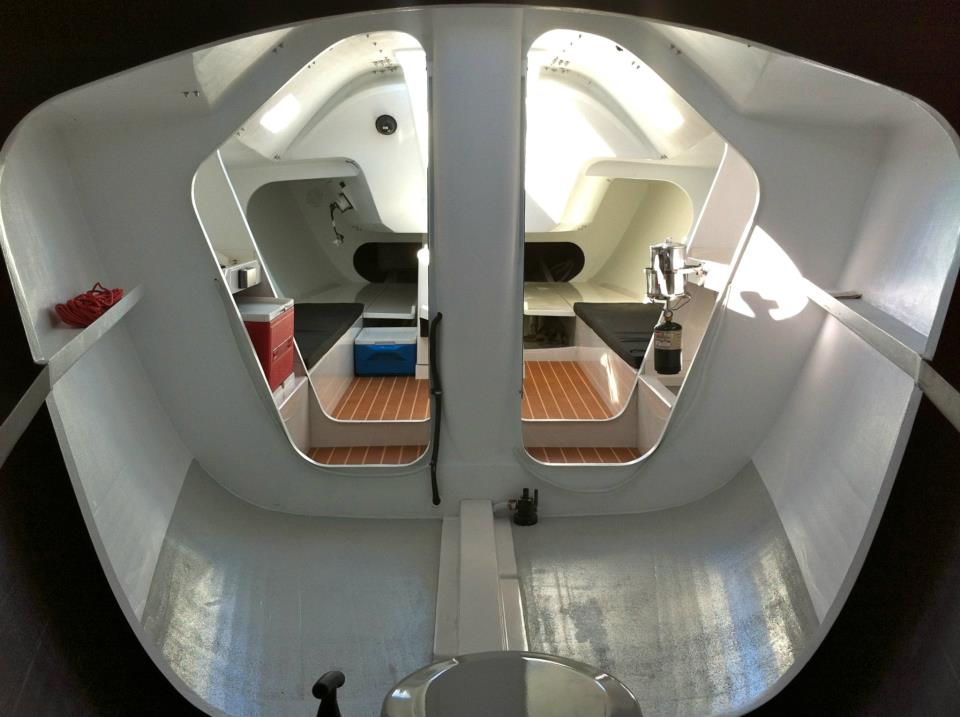
I had the opportunity to sit down with Geoff Trott, the general manager of Eos Design LLC , manufacturer of “Air Head” Composting Toilets. I was not really sure what to expect when interviewing someone for the first time, let alone someone who makes something that I know so little about. First, here is a summary of the “Air Head”, but more information can be found at www.airheadtoilet.com . The “Air Head” is a composting toilet for boats. While traditional marine heads (toilets) flush in some manner or another (auto vs. manual pump) and have holding tanks for all of the waste, the Airhead is a single unit that fits where your traditional marine head would go and skips the extra holding tanks. This is important, especially on a boat as small as mine, because those holding tanks take up a lot of room. The compact design makes it good for RV’s and Tiny Homes (tinyhouseblog.com) with limited space or septic hookup. The space consideration was something that helped to lead Geoff to develop the Airhead.
Geoff is a really interesting guy to talk to. While this was an interview, it felt a lot more like two old friends catching up after 10 years on their current projects, even though this was the first time I met Geoff. Geoff has been sailing since he was 16. He did some J24 racing when he was living in Connecticut, and has had the dream of living on a boat for years. Geoff is an engineer by training. When he left college, he wanted to help people, so went into corporate pharmaceuticals. After working for a while and having all the trappings of a corporate job, he realized that his life was missing something. This led him to leave the corporate world and buy a boat to live on. His first boat was a Wauquiez Centurion 32. This might seem like an insignificant detail, but this boat led Geoff to develop the Airhead. When he bought the boat, it did not have a head or holding tanks. The reason for the lack of holding tanks was because it was a European designed boat and overboard discharge even into the 90’s was the norm. The US was actually ahead of the curve on no-discharge rules. To comply with US regulations, Geoff bought a porta-potty to use. He would empty it about once a week, but found that it was difficult, messy, and the marinas were disinclined to let him empty the porta-potty in their bathrooms. He also couldn’t pump out the porta-potty at the pump-out station because it was not designed for it. With all of this frustration, Geoff started to think about different options. If he put in a 10 gallon holding tank with a traditional marine head, he would get 10 flushes and then have to pump out the tank. This was highly impractical. Then his thoughts turned to composting toilets.
Conventional wisdom in the 90’s for composting toilets was that you needed a large mass of biomass to compost. Therefore conventional composting toilets were quite large, too large for most boats. Additionally conventional composting toilets also created strong odors at the vent exit. This is where Geoff’s innovation came in. Composting toilets generally do not separate solids from liquids. When thinking about this, he thought about how animal poo does not smell once it dries out. If he could figure out a way to dry the solids, maybe he could get rid of the smell. He decided the easiest way to go about it was to just separate the liquids and solids when going into the toilet. In all of the research he did, it didn’t seem like it was going to work. Not to be deterred from his project, he made a prototype and started to use it to see if the proof of concept worked. Once he figured out that he needed a constant airflow through the solid’s tank, the smell of the composting toilet was pretty much all gone, This turned out to be a great solution to his boat with no real space for the traditional marine head.

When I asked Geoff if he made the head only as a space saving device, or, if it had an environmental component as well, he told me that it was both considerations. He had been interested in environmentally conscious technologies such as composting toilets and alternative energy, such as wind and solar. This interest developed from a love of the outdoors and concern about where the world is going. “I made a personal observation from 20 years of revisiting a pristine wilderness (Lake Colden, Adirondacks), and seeing the change due to human impact in this remote place. For even in these preserves with only foot traffic from people who generally care about the environment, the local ecosystem seemed to be stressed. Imagine human impact at a larger scale and how that might effect our world”. He believes in “carry in carry out” hiking and camping and sees waste disposal as something that needs to be addressed on a larger scale. As a surfer, he takes issues with cities dumping sewage overflow straight into the ocean. This not only affects him as a surfer, but it also contaminates beaches near the out flows, as well as shellfish that get harvested nearby. This certainly does not seem to affect the people who swim at the East End Beach in Portland. If, by using an “Air head”, it takes waste out of circulation, the removal of waste is a win in Geoff’s book. It also complies with no discharge rules in US waters. This is a plus to beach goers, surfers, marine wildlife, and pleasure boaters.
One of the other components of environmentalism that is present in this product is that it is made in the USA. This means there is less transport involved in getting the parts for final assembly, meaning that the toilet has a smaller carbon foot print. Also, by being made in the US, the quality control is better, and it creates jobs here in the States. This does get reflected in the price, but it appears that you get what you pay for. A competitor’s product ( Natures Head, which is an obvious copy of the “Air Head”), had seams between parts that did not meet, and had design flaws because it made opening and emptying nearly impossible in confined spaces. In general it is a not so well thought out head. For $125 less, it does not look like the money saved is worth the hassle.*

I also talked about Geoff’s 40’ Pilothouse sloop project. The boat is a Radovich designed boat with a fiberglass hull and wood deck. It was built and sailed primarily in California, but was then trucked to Lake Champlain. With the exception of the deck and deck support structure, the boat is in quite good shape. The deck was pretty much a total loss. It was plywood with teak screwed into it. The joinery between the teak pieces and the fact that it had been screwed directly into the plywood made the plywood sub flooring fail from the infiltration of water. This then led to leaking into the cabin and ruining bulkheads. The support beams were another story all together. They had been laminated pieces, but instead of being laminated vertically, they had been laminated horizontally. This gave them little strength, which meant that when stepped on they flexed downward underfoot. If that was not bad enough, when the boat had been wired, they drilled holes in the cross beams to allow the wiring to be run fore and aft, thus creating weak spots in the already weak frames. On top of all of this, some of the supports were eaten away by termites. This is quite the project he has for himself, but judging by his eye for quality control on his Airheads, the sloop is going to be gorgeous when finished.

Before I went to do this interview, I asked friends on Facebook what they would want to ask someone who makes composting toilets. The best question I got in response was this: If it is a composting toilet, what does your dog drink? Geoff laughed when I asked him, and thought about it. He recalled that he had a dog when he was in the development and testing phase, and that the dog did not even seem to notice the Airhead, so never developed the bad habit of drinking from the toilet.
All in all, it was a great experience to go and chat with Geoff about his product, project, and life aboard boats. I want to thank Geoff for taking the time to show me the shop, interview him, and write about him during his peak busy season. I certainly hope to run into him this summer when I am out on Casco Bay.
*This all based on evaluating one unit of theirs that I have seen and is my opinion.
Note: This interview was conducted and written in the summer. My apologies for taking so long to get it out to all of you hungry readers!
If you want more information, please check out
the Airhead website!
 So I spent a fair amount of my week of my week off from work thinking about my project and looking through electronics like Navigation lights, VHF radios, depth sounders, knot meters, etc. The trend in the nautical world is to network everything together and rely on that networked system for all of your information for navigation. I think this is silly, and would rather keep everything as simple as possible. When people only rely on the GPS rather than using their eyes, it can lead to running their boats aground, or worse, run them to their death. Things like solar flares and sun spots can throw off the GPS as much as several hundred feet. When you are used to making a passage within several hundred feet of an offshore obstacle, with your GPS telling you that you are in one place, when the reality is you are not where you GPS is showing. With that as a possibility, I would rather rely on dead reckoning, piloting, and navigation skills.
So I spent a fair amount of my week of my week off from work thinking about my project and looking through electronics like Navigation lights, VHF radios, depth sounders, knot meters, etc. The trend in the nautical world is to network everything together and rely on that networked system for all of your information for navigation. I think this is silly, and would rather keep everything as simple as possible. When people only rely on the GPS rather than using their eyes, it can lead to running their boats aground, or worse, run them to their death. Things like solar flares and sun spots can throw off the GPS as much as several hundred feet. When you are used to making a passage within several hundred feet of an offshore obstacle, with your GPS telling you that you are in one place, when the reality is you are not where you GPS is showing. With that as a possibility, I would rather rely on dead reckoning, piloting, and navigation skills.


























































